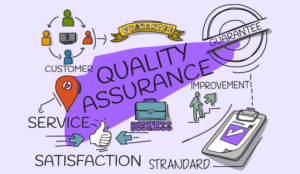We live in a data-centric world. From financial forecasts and interaction data to CRMs and WFM, call centre leaders are always reviewing information in the hopes of better understanding the business and delivering on strategic goals.
While there is clear value in this data, the sheer volume can be overwhelming. By leveraging your quality assurance function, you can cut through the noise and pinpoint relevant insights for your organization, taking your QA from tactical to strategic.
To do so, you need to understand why data matters for call centres and what you can do to unlock the real value of your quality assurance process.
What Is the Role of Data in a Call Centre?
Contact centres generate a lot of data from numerous different sources. Customer interactions, surveys, reviews, metadata—every function generates new information to be processed and, potentially, analyzed.
If used correctly, such a wide range of data can give insights into every aspect of your operations. By analyzing call centre data, you can improve customer experience, enhance operational efficiency, and make data-driven business decisions.
Using call centre data analytics to inform your decision-making process ensures that you’re taking actions based on the specific needs of your contact centre and correcting tangible issues.
To do so, you need to establish a strategy that supports the collection and analysis of all that data flowing into your call centre on a daily basis.
How to Use Data to Power Call Centre Customer Experience
Using data, you can identify strengths, weaknesses, and vulnerabilities in your call centre’s customer experience. Combining the right data with effective reporting and analysis will enable stronger decision-making based on real-time insights.
Interaction data, in particular, can provide insights into customer needs that shape your CX strategy and improve satisfaction. By analyzing agent-customer interactions, you can identify behavioral patterns and create personalized journeys to support the needs of each individual customer.
Speech and text analytics allow you to identify problems within your CX and improve agent performance. At the same time, predictive analytics take your raw data and use it to forecast the future of your contact centre, so you can tackle any issues proactively.
Why Are Standard Call Centre Metrics Not Enough to Measure Customer Experience?
Typically, call centre leaders use classic customer service metrics like customer satisfaction (CSAT) and Net Promoter Score (NPS) to measure CX.
While these KPIs are contact centre stalwarts for a reason—they provide a useful high-level overview of customer satisfaction—they have certain limitations when it comes to CX.
Missing Context
Typical call centre metrics like CSAT and NPS lack context, limiting their value as a measure of customer experience. They’re often based on isolated incidents, such as a single phone call, and so don’t fully reflect the entirety of a customer’s journey with your brand.
These journeys may involve multiple touchpoints across other channels before (or after) the phone call. While the individual interaction may be positive, these metrics fail to account for issues customers may have had with other parts of your business.
Siloed Data
Modern call centres can be complex, comprising multiple specialist departments and several channels of communication. With 69 percent of customers wanting the ability to switch between channels, information can become scattered.
This can lead to a lack of alignment and siloed data, resulting in a narrow perspective on your CX. In a sense, the data is also siloed in time, with CSAT and NPS surveys only reflecting a specific period. This limits your ability to rectify CX issues quickly.
Potential for Bias
Call centre surveys, the traditional method of collecting CSAT and NPS feedback, are prone to bias. In particular, a positive bias, whether intentional or not, can artificially enhance your survey results and give a false impression of your customer experience.
Potential areas for bias include question phrasing and flow, survey timing, and sampling. Generally speaking, customers who are either extremely happy or extremely unhappy are more likely to respond, leading to skewed results that don’t accurately represent your CX.
Transactional Focus
Not all measures of NPS are created equal. Depending on your requirements, you may be focused on transactional NPS or relational NPS. While each of these approaches uses the same survey methodology, they serve different purposes.
Relational NPS gives a broad overview of customer satisfaction and loyalty, whereas transactional NPS is more targeted, seeking feedback about a specific interaction. While the granular nature of transactional NPS can be useful, it’s too narrow to fully measure your CX.
Survey Fatigue
When it comes to gathering feedback, surveys are probably the most popular tool on the market. There are countless tools available to create and conduct surveys, and we’ve all received one at some point. However, this ubiquity can lead to survey fatigue.
If you overwhelm customers with survey requests, they’ll be less likely to complete them and, even if they do, there’s a risk that they’ll rush through it, leading to poor-quality data and wasted effort on your part.
What Is Call Centre Quality Assurance?
For call centres, quality assurance is about reviewing and analyzing interactions to ensure that they meet internal quality standards, with the aim of improving operational efficiency, agent performance, customer experience, and more. Typical QA methods include scorecard evaluations, call recording, and call quality monitoring.
A comprehensive QA process offers insights into every aspect of a contact centre, from customer satisfaction and agent engagement to budgeting strategy and the impact of call centre technology.
These insights allow leaders to identify areas for concern and ensure that every agent-customer interaction is geared towards supporting wider business goals.
How to Gather Essential Call Centre Data Using QA
A natural byproduct of the quality assurance process is the collection of data. By planning and refining this process, you can ensure that you’re gathering relevant data in an efficient manner.
Of course, you’ll need a QA team, a defined process, and clear aims, but let’s look at some specific techniques to enhance data quality.
Analyze Conversations Across Multiple Channels
78 percent of customers want to engage with organizations on their preferred channels, and most modern contact centres embrace this with an omnichannel approach. This means lots of data in lots of different places, so it’s important that you analyze every channel.
By combining and reviewing data from multiple channels, you can get a comprehensive overview of customer journeys and agent performance across the entire call centre ecosystem, giving necessary context to CX insights.
Identify Customer Experience Trends Through Metadata
With most contact centres generating a significant volume of data on a daily basis, metadata can be a useful tool to help organize and understand all of this information. By linking quality assurance to your CRM and other tools, you can give context to interaction data.
Using metadata, you can identify trends and patterns in your customer base and get a stronger understanding of how customers interact with your brand. This allows you to make data-driven decisions based on long-term trends and identified patterns.
Leverage Call Centre QA Scores
Evaluations are a key part of the overall QA process, allowing you to understand and improve the quality of agent-customer interactions. By leveraging data from scorecards and the associated evaluator comments, you can build a clear picture of agent performance.
This data is particularly valuable as it informs coaching sessions, call centre training programs, and overall customer support strategy in your organization. Many modern QA solutions combine scorecard data with reporting and analysis so you can easily identify insights.
Assess Call Centre Process Efficiencies
Measuring operational efficiency is an important aspect of the quality assurance process, with metrics like average handling time (AHT), service level, and call abandonment rate used to assess organizational productivity.
To get the complete picture of your call centre’s efficiency, you need to ensure that all employees who interact with customers are evaluated as part of the QA process. Additionally, standardizing and calibrating evaluation will ensure consistency.
Unlock the Strategic Value of Call Centre Quality Assurance
The quality assurance process involves gathering valuable data on virtually every aspect of your call centre’s operations. By leveraging this information effectively, you can inform organizational strategy and unlock the hidden value of QA.
While many organizations use QA as a tactical tool—focused on real-time fixes and short- to medium-term solutions—a more strategic approach to QA can support the long-term success of your business.
Strategy is about building a blueprint for your organization’s future, and QA can offer invaluable insights that allow executive management to make key decisions with confidence, leading to improvements in CX, efficiency, loyalty, and more.
Let’s look at some key steps you can take to transform your QA process from tactical to strategic.
Look Beyond the Numbers
Numbers are the basis of many typical call centre metrics, particularly those focused on productivity, like average time in queue and average speed of answer, but numbers alone don’t give sufficient context for long-term strategy.
QA provides a lot of qualitative information about customers, from retention rates to overall sentiment. You can use these insights to develop a strategic approach that turns customers into brand advocates.
By focusing more on the human element and your ability to build lasting relationships with customers, you can cement loyalty, improve brand reputation, and even increase revenue potential.
Treat the Problem, Not the Symptoms
As noted, tactical QA is often focused on fixing issues quickly and taking short-term actions. While this is beneficial in the fast-paced call centre industry, it doesn’t dig down to the root cause of problems and instead tackles the symptoms.
An unhappy customer is a symptom of poor CX—you need to find the underlying cause. This involves a deeper analysis of the customer journey. What are the most impactful touchpoints? What issues are causing repeat calls?
By carrying out an in-depth analysis of the data, you can address the problem at source and correct issues before they occur, instead of playing catch up later on. This proactive approach supports effective, long-term solutions.
Analyze the ‘Why’ Behind the Contact
QA data doesn’t only tell you how many customers are calling—if you dig deeper, it can also tell you why they’re calling. Understanding why customers reach out allows you to better address their needs and bridge the gap between expectations and experience.
If customers keep calling to ask the same question about subscription costs, for example, maybe you need to update your website’s pricing page to explain it more clearly. This way, you can improve the customer journey, better allocate resources, and save time.
Invest in Skill and Experience
More experienced evaluators may be more expensive to hire initially, but they pay off in the long run. Not only are they important to the quality assurance process, but they can also help identify inefficiencies within the organization that are wasting resources.
Experienced evaluators can identify broken processes, poor scheduling, and agent skill gaps—all of which are costing your organization money. Additionally, their ability to manage and streamline the QA process leads to better CX and improved agent engagement.
Leverage the Power of Business Intelligence
Leveraging business intelligence alongside QA can elevate the value of the quality assurance process and unlock the hidden insights. Business intelligence makes sense of raw, unstructured data, so you can pick out the relevant points.
Effective business intelligence tools simplify the reporting process and deliver the results via visual dashboards, showcasing the value of QA to everyone involved, so stakeholders can see the correlation between high-quality CX and stronger business outcomes.
Our new tool, Scorebuddy BI, is the most comprehensive QA business intelligence solution on the market, allowing you to create powerful QA reports in just a few clicks, so you can develop long-term strategies to boost CX, retention, and revenue generation.
Bring the Data to the Top
While the quality assurance process is often seen as the realm of QA specialists, the insights it provides are beneficial to everyone, from CS and sales to marketing and product. Where QA data can have the biggest impact, however, is at the top.
By sharing insights with the C-suite, you can ensure that QA supports the overall company strategy and enables data-driven business decisions based on up-to-date, accurate information.
Quality assurance can help executive management strategize around resource allocation, product offerings, marketing approaches, and more, supporting cross-functional collaboration in pursuit of core business goals.
Conclusion
Quality assurance is a secret weapon for call centre executives. With a ton of data pouring in from interactions, surveys, reviews, and more, you can leverage QA to manage all this information and extract relevant insights.
By using QA as a strategic tool, you can improve customer experience and operational efficiency with informed decision-making and ensure that your long-term strategy is backed up by the latest data.
This blog post has been re-published by kind permission of Scorebuddy – View the Original Article
For more information about Scorebuddy - visit the Scorebuddy Website
Call Centre Helper is not responsible for the content of these guest blog posts. The opinions expressed in this article are those of the author, and do not necessarily reflect those of Call Centre Helper.
Author: Scorebuddy
Published On: 29th Aug 2023 - Last modified: 9th Dec 2024
Read more about - Guest Blogs, Scorebuddy






 Scorebuddy is quality assurance solution for scoring customer service calls, emails and web chat. It is a dedicated, stand-alone staff scoring system based in the cloud, requiring no integration.
Scorebuddy is quality assurance solution for scoring customer service calls, emails and web chat. It is a dedicated, stand-alone staff scoring system based in the cloud, requiring no integration. 






























